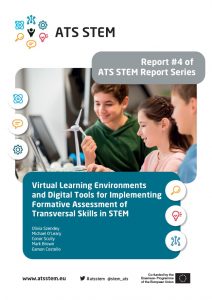16 Dec 4 Virtual Learning Environments and Digital Tools for Implementing Formative Assessment of Transversal Skills in STEM
Virtual Learning Environments and Digital Tools for Implementing Formative Assessment of Transversal Skills in STEM
“Understanding the affordances, dimensions, and presences offered by digital tools is important, however there are several contextual factors that affect how such tools are actually used. For the formative assessment potential of digital tools to be realised, they have to be implemented in accordance with contemporary theories of learning and be backed up with sound empirical research (which, for many of the types of architecture discussed, is at an early stage).”Key takeaways
- Nine different categories of architectures are featured in the report with the potential of each for formative assessment purposes within the STEM content domains outlined and evaluated.
- Policy makers can benefit from noting the listed architectures and in turn promote effective technology use in the creation of new knowledge and educational content.
- For teachers and teacher educators, the report provides guidance for the use of digital tools and associated architectures that can be implemented or adapted to support formative assessment of Science, Technology, Engineering, and Mathematics (STEM) transversal skills.
- Formative assessment tools outlined in the report will encourage teachers and/or students to modify teaching and/or learning to meet immediate educational needs.
- The report was written to guide decision-making around the choice and design of formative assessment software in STEM contexts.
The Report
This report was written as a part of a research project titled Assessment of Transversal Skills in STEM (ATS STEM) funded by Erasmus+. It is the fourth in a series of five reports based on deliverables related to the project, foregrounding the discussion in a number of seminal frameworks for technology-enhanced learning and then outlines the potential of nine digital architectures to be used for formative assessment.
It categorises these nine architectures into Virtual Learning Environments (VLEs) and Digital Assessment Tools. VLEs are online platforms that facilitate different kinds of interactions between students and teachers. Six VLEs are discussed:
- Content Management Systems (CMS): virtual environments that allow for the storage and access of files. These files can be uploaded and downloaded by both students and teachers.
- Learning Management Systems (LMS): platforms that allow for instructors to post course materials, interact with students, set assignments and return work to students.
- ePortfolios: “systematic collections of student work selected to provide information about students’ attitudes and motivation, level of development and growth over time”.
- Learning Analytics/Data Dashboards: Learning Analytics refers to the collection of information about learners, which can then be presented in illustrative ways.
- Adaptive Learning Systems/Intelligent Tutoring Systems: provide “tailored learning materials or activities to cater for personalised learning needs”
- Games: there are many different ways that games can be used for formative assessment, and a large industry has developed around the production of educational games. It is argued in this report that while games do have formative assessment potential, it is important for educators to think critically about the potential exaggeration of the educational possibilities of games.
Digital Assessment Tools are specifically designed for assessment purposes. Three are discussed: E-items, Computer Adaptive Testing (CAT), and Classroom Response Systems (CRS). Drawing on the concept of affordances, it is argued that while many digital technologies have the potential to be used for formative assessment, there are various mitigating factors that affect whether this happens in practice. The use of technology for formative assessment purposes is possible only when effective pedagogical strategies are deployed by educators.



